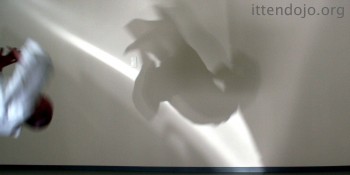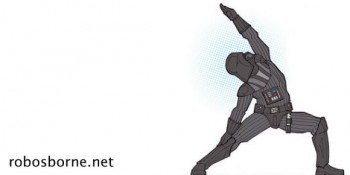Growing up, I wanted to be a Jedi like my favorite characters in Star Wars : training with lightsabers, using the power of my mind to control my environment, and realizing galactic-sized accomplishments. Mostly, I associated being a Jedi with power and running your own life. (Of course, that isn’t entirely accurate, but 9-year-old me liked to pick and choose the information I absorbed.)
: training with lightsabers, using the power of my mind to control my environment, and realizing galactic-sized accomplishments. Mostly, I associated being a Jedi with power and running your own life. (Of course, that isn’t entirely accurate, but 9-year-old me liked to pick and choose the information I absorbed.)
A decade and a half later, I decided to revisit my ambitions of becoming a Jedi, but not for the power (which leads to the dark side), but for the mindfulness.
I didn’t realize it when I was younger, but being a Jedi has more to do with your mind than with your body. And on my quest to improve my physical health, I discovered that yoga and Jedi training have a lot of similarities. I found that not only were the physical benefits of yoga amazing (greater flexibility, less muscle soreness after working out, better posture, less pain in old injuries), but the mental and spiritual benefits far surpassed my expectations.
Like a Jedi, who needs a master to train him, throughout my own mindfulness practice, Yoda frequently pops into my head. This funny little green man with his backward phrasing whispers words of encouragement as I try to align myself with the Force.
I had read up on yoga practices before attempting any poses, and my anxiety had already gotten the better of me and psyched me out. I had to win at this. I kept thinking that maybe if I were as prepared as possible, I could be really good at it, blow through the different yoga positions, master each one in turn. But I couldn’t relax and enjoy the moment.
So I began my first day on a yoga mat with the book The Yoga Body Diet in front of me. When I couldn’t balance in several poses in the workout, I immediately became frustrated, angry with myself for not being able to do something I viewed as simple. I couldn’t do it. And just as I was about to scold myself for being incompetent, a voice popped into my head.
in front of me. When I couldn’t balance in several poses in the workout, I immediately became frustrated, angry with myself for not being able to do something I viewed as simple. I couldn’t do it. And just as I was about to scold myself for being incompetent, a voice popped into my head.
Fear is the path to the dark side. Fear leads to anger; anger leads to hate; hate leads to suffering.
I feared I would fail. I became angry when I didn’t immediately master the yoga practice, and if I continued down this path, not only would I suffer, but those around me would as well. I didn’t want to turn into Darth Vader.
Shannon Paige, writer, sacred activist, and yoga teacher, said during one of her TED talks that yoga doesn’t solve depression or heal broken hearts, but it works as a mindfulness tool in overcoming these parts of life because “yoga works by creating the mind, body, breath connection.”
To connect mind, body, and breath and create self-awareness. To connect with yourself and with what’s around you. To tap into the Force. That’s what I want. But I knew I wasn’t in a good place to start with in that moment.
In a dark place we find ourselves, and a little more knowledge lights our way.
Thank you, Yoda.
And light my way it did. I started with step 1 instead of jumping into the poses. I started with breathing. It was time to “unlearn what you have learned,” as Yoda would say. I learned that the body interacts with the breath at a specific point in the respiratory cycle to give you a place where you learn new information, both mental and muscular.
“At the very emptiest point of every breath that you have, just before the breath becomes an inhale, you have the capacity to learn something new. Just depends on what you’re learning,” Paige said.
And with each breath, I began unlearning and letting go of 25 years of backed-up negativity: my fears of inadequacies, rejections, disappointments, failures, and what-ifs. Because I had held onto everything for so long, I couldn’t even imagine being happy, let alone actually experience it. But with each deep breath — the kind that fills your entire body — I began to look at my accomplishments, relationships, and friendships and restore my belief in myself.
Train yourself to let go of everything you fear to lose.
— Yoda to Anakin Skywalker in Revenge of the Sith
I fear so much, but in letting go of some of those fears, maybe I can find some peace and calm. The fears will always exist, as will the negative things and tragic occurrences in this life, but it’s how we react to them that allows us to experience peace and a connection with the Force.
I had wanted yoga to solve my anxiety and depression problems, but yoga isn’t about solving problems to create peace and calm. It’s about what goes on inside ourselves each and every day.
Most modern yoga actually creates tension in order to teach you how to release it. Breathe in tension and then breathe it out. It’s not about our weight, anxiety, depression, illness, or heartbreak. Yoga is about connection and those links between our mind, body, spirit, and the Force. And now I feel that connection each day.
What you get out of daily mindfulness practice is what you put into it. “You only find what you bring in,” the Jedi master said to Luke Skywalker before he entered the cave in The Empire Strikes Back. Similarly, if you go into yoga with your type-A personality and think it’s going to solve all your problems, you’re sure to be disappointed. But if you start practice with the mindset that you’re going to understand yourself better and that this will help you take control of yourself and your surroundings and your interactions with others — Do or do not, there is no try — if you can do that, then there’s no telling where you may end up and what you may discover about yourself.
And if you start to feel disconnected again, just remember to breathe.
Size matters not. Look at me. Judge me by my size, do you? Hmm? Hmm. And well you should not. For my ally is the Force, and a powerful ally it is. Life creates it, makes it grow. Its energy surrounds us and binds us. Luminous beings are we, not this crude matter. You must feel the Force around you; here, between you, me, the tree, the rock, everywhere, yes. Even between the land and the ship.
— Yoda to Luke Skywalker on Dagobah in The Empire Strikes Back



